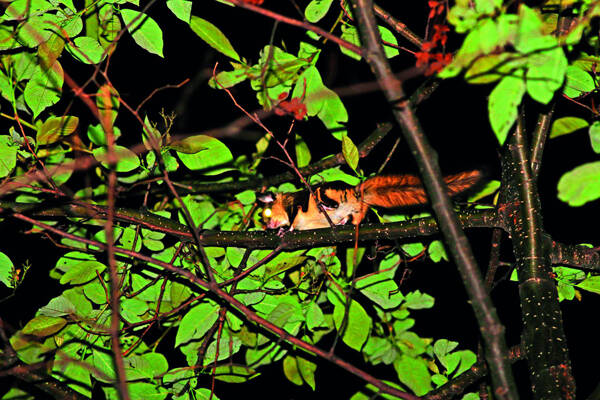Hylopetes alboniger
IUCN
LCBasic Information
Scientific classification
- name:Hylopetes alboniger
- Scientific Name:Hylopetes alboniger, black and white flying squirrel, arrow-tailed black and white flying squirrel
- Outline:Rodents
- Family:Rodentia Sciuridae Hypoplasma
Vital signs
- length:
- Weight:
- lifetime:
Feature
The back of the body is dark brown, the chest and arms on the ventral side are white, and the fur is all white.
Distribution and Habitat
Distributed in Yunnan, Guizhou, Chongqing, Sichuan, Guangxi and Hainan.
Inhabits tropical and subtropical forest environments. Most nest in tree holes, hiding during the day and coming out at night. Food is mainly plant fruits, seeds, young branches and leaves, etc.
Appearance
Adults are larger than flying squirrels. They have no ear tufts and their tails are slightly flat (feathery). Their cheeks are gray, and the back of their bodies is mainly brown-gray. The edges of their wing membranes are white, and the ventral surface of their bodies is white or grayish white. The back of their front and back feet are brown-gray. The back of their tails is black-gray, and the back part gradually turns black.
Details
The black-and-white flying squirrel is a small flying squirrel in southern China. The adult is less than 250 mm long. It is active at night, sleeps in the nest during the day, and is active at dusk and dawn. Usually, several live in the same nest. When sleeping, the head is hidden between the front and back feet, and the tail covers the body. It is not as flexible as squirrels when climbing trees. It moves by gliding, climbing trees, and climbing trees. It is good at gliding when moving. The gliding distance depends on the terrain and the distance between trees, usually about 30 meters.

Black and white flying squirrels use tree holes as their nests, mostly in the holes at the lower edge of the tree fork, the cracks where branches are cut off, or in holes that have decayed due to years of wind and rain erosion. Generally, the entrance of the tree hole is only 10 meters below the ground. The hole is at a 90-degree angle to the tree trunk, or slightly tilted downward. The length of the hole can reach 3-5 meters. The nest is cushioned with moss, vines, or grass. The structure of the nest is simple.
Black and white flying squirrels like to drink water and feed on fruits, including banyan fruit, mango, walnut, chestnut, corn, etc., especially walnut. They often store food. In September and October, they hide mature walnuts, chestnuts, chestnuts, corn, etc. in the soil near tree holes for winter consumption. Black and white flying squirrels eat like squirrels. When eating, they use their front paws to grasp food, and their tails are raised and attached to their backs.
The natural enemies of black and white flying squirrels are cats, weasels and arboreal carnivores.
Black and white flying squirrels breed and mate from May to July, and their calls are sharp at this time. They give birth to one litter per year, with 1-4 pups per litter, usually 2-3 pups, and a gestation period of about 40 days. The sex of each litter varies, and there are several pups of the same sex in one litter. After the female gives birth, the male and female live separately. In the four seasons of the year, except for the young mice seen in September and October, they are rarely caught in other seasons. The young often live with the mother and sleep under her belly.
In China, there are not many black and white flying squirrels, probably more in western Yunnan and a small number in the southern mountainous areas of Zhejiang. The main threat to black and white flying squirrels is habitat disturbance or destruction, and indiscriminate hunting may also be a factor.
Listed in the 2008 Red List of Endangered Species of the World Conservation Union (IUCN) ver 3.1 - Least Concern (LC).








